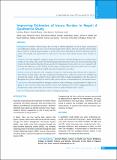Please use this identifier to cite or link to this item:
https://hdl.handle.net/20.500.14356/888| Title: | Improving Estimates of Injury Burden in Nepal: A Qualitative Study |
| Authors: | Bhatta, Sumiksha Bhatta, Santosh Mytton, Julie Joshi, Sunil Kumar |
| Citation: | BhattaS., BhattaS., MyttonJ., & JoshiS. K. (2022). Improving Estimates of Injury Burden in Nepal: A Qualitative Study . Journal of Nepal Health Research Council, 20(02), 339-346. https://doi.org/10.33314/jnhrc.v20i02.3929 |
| Issue Date: | 2022 |
| Publisher: | Nepal Health Research Council |
| Keywords: | Injury data Nepal Qualitative study Recording and reporting |
| Series/Report no.: | April-June, 2022;3929 |
| Abstract: | Abstract Background: Routinely collected injury data can help to identify populations at risk of injury, circumstances surrounding those injuries, and can be used to develop targeted interventions. However, routinely collected injury data in Nepal are at risk of being incomplete or poorly coded and are underutilised. Therefore, this study aimed to explore the strengths, and opportunities for improvement, of systems that routinely measure injury incidence in Nepal. Methods: This study employed a qualitative design where data were collected through interviews with personnel working in four routine data systems; the Health Management Information System, the Road Accident Reporting System, the Daily Incident Reporting System, and the Civil Registration System. Interviews were conducted with front-line data collectors as well as strategic decision makers working in these data systems. Interviews were audio-recorded, transcribed, translated into English and analysed using framework analysis. Results: A total of 32 interviews were completed, 19 interviews with front-line data collectors and 13 interviews with strategic decision makers. The data recording and reporting process of the four systems were identified and described. The analysis of data yielded 11 themes that described the strengths and limitations of the data collected through the four systems, challenges for effective data systems, and user recommendations for system improvement. Conclusions: This study identified the strengths, limitations, system challenges, and opportunities to improve data quality of each of the four routine data collection systems. These findings may be useful in engaging stakeholders in strengthening existing routine injury data collection systems or implementing alternative systems. Keywords: Injury data; Nepal; qualitative study; recording and reporting |
| Description: | Original Article |
| URI: | http://103.69.126.140:8080/handle/20.500.14356/888 |
| ISSN: | Print ISSN: 1727-5482; Online ISSN: 1999-6217 |
| Appears in Collections: | Vol 20 No 02 Issue 55 April-June, 2022 |
Files in This Item:
| File | Description | Size | Format | |
|---|---|---|---|---|
| 3929-Manuscript-29677-2-10-20221103.pdf | Full Article. | 903.16 kB | Adobe PDF |  View/Open |
Items in DSpace are protected by copyright, with all rights reserved, unless otherwise indicated.
